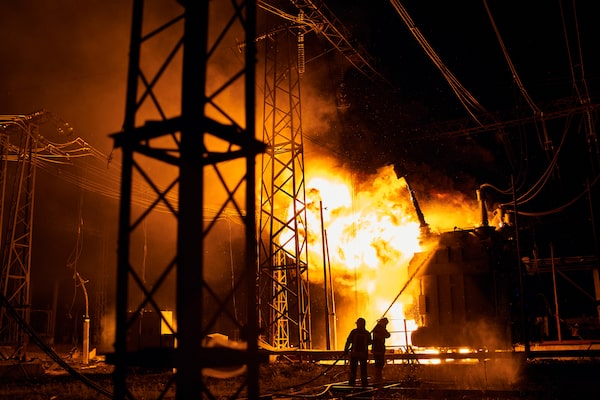
Destroyed armoured vehicles litter the road in Balakliya, Kharkiv region, on Sept. 10, 2022.JUAN BARRETO/AFP/Getty Images
Ukrainian troops continued their weeklong push in the eastern Kharkiv region on Monday, liberating more villages and towns as the Russian forces that had occupied the region since March scattered in chaotic retreat.
All of a sudden, cities and towns such as Kupyansk and Izyum that had been centres of Russia’s political and military control are back under the blue-and-yellow Ukrainian flag. Cities that the Russian army spent weeks trying to capture this year, such as Lysychansk, in the neighbouring Luhansk region, are once more on the front line, this time with Ukrainian forces on the advance.
General Valery Zaluzhny, the commander of Ukraine’s military, said on Sunday that more than 3,000 square kilometres – an area larger than Luxembourg – had been retaken since the start of September, and that Ukrainian forces were now within 50 kilometres of the Russian border in parts of the Kharkiv region.
Later in the day, videos posted online suggested Ukrainian forces had entered several settlements at or near the formal border between the two countries.
The Ukrainian counterattack marks the biggest shift in the front lines since April, when Russian forces withdrew from around Kyiv after a failed attempt to capture the capital.

Ukrainian State Emergency Service firefighters put out a fire after a Russian rocket attack hit an electric power station in Kharkiv on Sept. 11, 2022.Kostiantyn Liberov/The Associated Press
Russia acknowledged having lost control of parts of the Kharkiv region, including its former military hub of Izyum and the nearby city of Balakliya, but said it was part of a larger plan to focus on the goal of taking the nearby Donetsk region, where Russian forces have made little progress since capturing the cities of Lysychansk and Sieverodonetsk in June.
“It was decided to regroup the Russian forces stationed near Balakliya and Izyum to boost efforts in the Donetsk direction,” the Russian Defence Ministry said.
The city of Kharkiv, Ukraine’s second-largest with a prewar population of 1.4 million, was blacked out Sunday night. Regional Governor Oleh Synyehubov said electricity and water supplies were affected after Russian missiles struck unspecified “critical infrastructure.”
Ukrainian service members pose for a photo in the recently liberated settlement of Vasylenkove in the Kharkiv region in this handout picture released Sept. 10, 2022.TERRITORIAL DEFENCE OF THE UKRAI/Reuters
As well, Russian forces hit energy infrastructure in the central Ukrainian region of Dnipropetrovsk on Sunday, knocking out power supplies to several towns, that region’s Governor said.
“Some towns and communities are without power. The Russians have hit energy infrastructure. They are unable to reconcile themselves to defeats on the battlefield,” Valentyn Reznichenko wrote on Telegram.
The full extent of the Ukrainian advance in Kharkiv was not immediately verifiable, as the military has barred media from the front line in recent weeks, part of a strategy that allowed them to launch the surprise counterattack. But videos posted on social media showed crowds of residents, some of them sobbing with joy, running into the streets to greet the Ukrainian forces that had ended the six-month-long occupation of their towns and villages.
In several newly liberated towns, propaganda posters declaring, “We and Russia are one people,” were torn down from billboards by Ukrainian troops.

Ukrainian flags are placed on statues in a square in Balakliya, Kharkiv region, on Sept. 10, 2022.JUAN BARRETO/AFP/Getty Images
Other videos showed lines of abandoned Russian tanks and other weaponry, much of it marked with the “Z” and “V” symbols used to identify vehicles taking part in the 200-day-old invasion of Ukraine.
The success of the Kharkiv offensive appears at least partly because of months of Ukrainian messaging that its main counterattack would come in the southern Kherson region. As Russia redeployed units south to defend Kherson, Ukraine suddenly pushed forward in Kharkiv.
“There was a huge disinformation campaign about real direction of the offensive. So Russians expected Ukrainian offensive to start on the south in Kherson, but it started in Kharkiv. So, it looks like the Ukrainians, you know, fooled the Russians,” said Taras Berezovets, a veteran political analyst who now serves as a press officer embedded with Ukrainian special forces.
“There was huge panic among the Russians. We saw them from our drones. They were jumping in Siverskiy Donets [River]. Some were in their underwear, because they left their uniforms.”
Anton Gerashchenko, an adviser to Ukraine’s Interior Ministry, posted on his Telegram channel that Ukraine had captured 20 abandoned Russian tanks, plus 20 more that needed repairs, as well as 10 pieces of artillery and dozens of armoured personnel carriers and infantry fighting vehicles.
However, there was also evidence suggesting Russian troops had committed atrocities, including extrajudicial executions, in the areas it had occupied.
Following the Russian withdrawal from the Kyiv region in April, Ukrainian forces recovered hundreds of bodies. Many of the victims had been shot in the head after their hands had been tied behind their backs.
Mr. Gerashchenko said two bodies that had been “tortured and shot in their heads” had already been recovered in the Kharkiv area. “Bucha was occupied for 33 days. Territories that are being liberated now were occupied for more than six months,” he said.
With a report from Reuters
 Mark MacKinnon
Mark MacKinnon